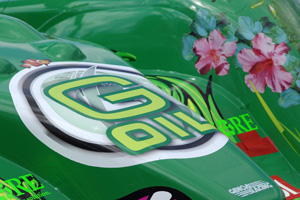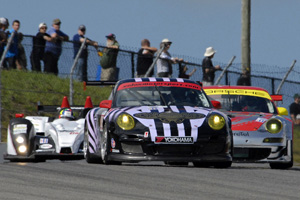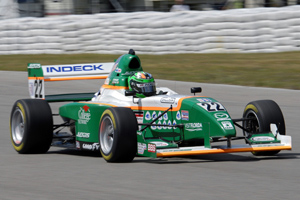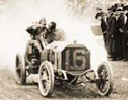Mosport Diary:
Day One
Green Racing Driving
Bowmanville, Ontario, Canada, August 27 — Making racing relevant has been an age old quest ever since the sport began. Recently, unless you've been living under a rock, you know the key relevance factor is green racing. The American Le Mans Series has been at the forefront of this effort, more so than perhaps any other racing series in the world. They even receive support from the U.S. Department of Energy.
It could be argued whether we really are suffering from global warming (and I'm one of those skeptics) or simply a hiccup in the natural course of the Earth's climatic history. It could also be argued if global warming is caused by humans (and I'm definitely in the camp of being highly suspicious of this assertion) or simply another spike in the Earth's warming history since the last Ice Age (ask the Woolly Mammoth what they think of global warming and whether humans could be blamed for it).
 The #99 Green Earth Team Gunnar LMPC entry uses G-Oil, a specially formulated biodegradable engine oil.
The #99 Green Earth Team Gunnar LMPC entry uses G-Oil, a specially formulated biodegradable engine oil.
However, all those opinions don't matter. What matters is, we should always be looking for ways to improve the environment we live in. It was not too long ago when we suffered through smog filled cities. burning rivers in Cleveland, and garbage infested lands enough to make a Native American shed a tear (even though the part in the famous commercial was not played by a Native American). Global warming or not, anything we can do to make the Earth a better place to live is a good thing.
Of course, what is a worthwhile plan and what is not is always open to debate. Is Ethanol really the answer to the alternative fuel question or more of a problem causing lower fuel mileage, corrosive damage to engines, and food price spikes in third world countries? Is the government truly looking at the whole picture with various green technology funding, or are they taking the route of least resistance, catering to the special interest groups, and trying to win some quick votes from their constituency? This is my biggest concern -- the government's true motivation.
Last week, my wife and I drove from Rochester, N.Y. to Long Island to visit my sister. We made it from our house to just outside the George Washington Bridge in five hours. We were making good time. Then, traffic ground to a halt. This particular area has numerous mergers, lanes disappearing, multiple routes coming and going, and a double deck bridge which eventually has to flow back together. On a normal day, this combination of ingress and egress can slow the flow down. On a day when they were doing emergency weekend work on the Major Deegan Expressway (I-87), even though it was after the bridge, it can trigger a domino effect of backups. Couple that with a Yankees game, and you have bottlenecks of epic proportions.
 Could traffic control on the race track somehow help solve traffic control on the highways?
Could traffic control on the race track somehow help solve traffic control on the highways?
We were about two miles or so from the toll booths. Yet, it took us one hour and 45 minutes to get through them. That's right, 105 minutes to go about two, perhaps three, miles. Even after going through the toll booths (at a speed which a baby could push a car faster), it still took us another 45 minutes to get across the bridge. Then, when it came time to merge onto the Cross Bronx Expressway, we didn't move at all. By that point, I bailed, and shot down an exit which dumped me in the Bronx. I wound my way on side roads before getting back on the Cross Bronx past the point of the Major Deegan where traffic was finally moving at a decent pace.
Besides the headache and the hours lost out of my life, just think of the environmental impact of such a traffic jam. The amount of emissions spewing from all these cars at a standstill even for that one day probably offsets all the gains made from various green technologies and changing public behavior. There have been numerous studies that have shown traffic is one of the worst offenders of greenhouse emissions, right up there with poorly tuned cars.
And therein lays the hypocrisy of some of these green initiatives. Toll booths are a horribly inefficient, pollution causing device. Yet, no government will ever get rid of them as they will always choose green money over green driving. There are some new technologies pertaining to paying tolls. Toronto's expensive toll bypass reads your license plate and sends you the bill in the mail. You never slow down. Chicago's highways now allow E-ZPass holders to zip through the toll barriers at highway speeds as the signals are read with receivers high above the highway. However, these advances are currently the exception rather than the rule.
Construction work is a huge burden on traffic, especially during rush hour. Yet, how well is this work planned in both time of day and location? Paying construction workers the premium for graveyard shifts and spreading the work out over time cost municipalities money. Improving lane mergers and the like also cost money. Governments have no trouble making the citizenship pay for green driving, taking money from special interest groups, passing laws to force manufacturers to be more efficient, and looking good pushing "free" programs, but when it comes to their own investment in the environment, they are nowhere to be seen.
I also have to wonder, can racing help out? Is there anything racing has learned in track design that can help lane mergers? Are racing transponders the answer to slow toll booths? Does race control have anything to contribute to alleviating traffic jams?
What the American Le Mans Series is doing in their Green Racing may be great, but perhaps it's time to get really bold. Perhaps, it's time to really think beyond the obvious. Perhaps, racing has more to offer that no one is currently considering.
Speed Con(n)or. Meanwhile, on the track in the first day of action at Mosport under beautiful conditions, the two Americans named Con(n)or (no matter how each one spells their first name) topped the practice timing charts in the Star Mazda Championship presented by Goodyear. Conor Daly turned a 1:15.413 while Connor De Phillippi did a best lap of 1:15.657 around the 2.459-mile track.
 Conor Daly turned the fastest Star Mazda lap time after the first two practice sessions.
Conor Daly turned the fastest Star Mazda lap time after the first two practice sessions.
The Mobil 1 presents the Grand Prix of Mosport had what were called test sessions in the afternoon. The prototype class had quite a day with the Patón Highcroft Racing ARX-01c turning in the slowest time amongst the LMP cars that ran. The Muscle Mile CytoSport entry topped the charts with a 1:07.801. This could bode well for a very exciting race for overall honors come Sunday. We'll have to see who can and cannot find speed between now and then.
Photos by
Copyright © 2010 by Russell Jaslow and Deep Throttle. All Rights Reserved.
| 



